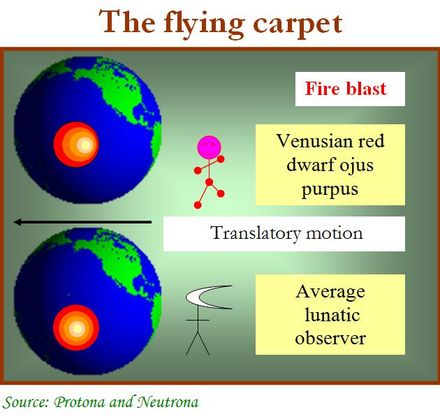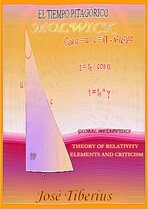2.c.1.a) Heliocentric model and Ptolemaic system
The ideas regarding the correct interpretation of reference frames are in section Relativistic Physics about The non-distinction between physical or real velocity and relative, mental or abstract velocity.
When discussing reference systems, a classical controversy comes to mind: between the geocentric theory or Ptolemaic system of the Greeks and the heliocentric model of Copernicus. It is essential to take into account that both are correct, as they are merely conventions. The difference is that the heliocentric model is far more straightforward mathematically and logically than the Ptolemaic system –naturally, as long as we are referring to the description of the movements of the planets in the Solar System.
The conventional correction of both heliocentric system and Ptolemy’s geocentric model is a frequent example that any new theory must incorporate the previous one as a particular case. Nothing could be further from scientific reality; we hope it will be enough to mention the Earth being flat or round. Apparently, the current theory concerning the terrestrial globe does not include the previous one.
Just so there is no room for doubt, we completely accept the need for a frame of reference –however simple it may be– to define the movement. In other words, we share the principle that all movement is relative; we might even go so far as to say all thinking is relative.
A frame or system of reference can apply to any object, matter, or even a thought; but the reasoning behind this topic refers to a spatial frame of reference.
We believe spatial dimensions are no more than abstract concepts; by their nature or construction, they have a symbolic and absolute character to help the reasoning of the brain and with a conventional spatial origin. Even with the idea of a natural reference system, space is still a concept with a conventional spatial origin.
In this sense, space exists in mind without needing a physical reality. What’s more, its physical reality –if indeed it exists– would not add anything to the concept.
At least, that is what we understood when they explained it to us when were little.
Despite movement being relative by pure tautology, we must figure out if there are natural reference systems more appropriate than others are. When we walk along the ground, natural reference system, or most common, or most useful, tells us we are moving and the ground is not. Of course, other points of view do exist, but they are not as powerful when explaining or attaining particular objectives. In other words, for these objectives, the best model seems to be a Ptolemaic system or geocentric model that makes the Earth-fixed.
A typical case of reference systems known to all of us is the heliocentric system applied to the solar system, as I mentioned previously. Who goes in circles around whom on the dance floor?
If we take the Earth as the origin of our reference frame, we find the Aristotle system, and subsequently the model of Greek astronomer Claudius Ptolemy, of 2nd century AD. In his treatise the Almagest, he put forth his hypothesis of consistent epicycles in circular orbits around the rest of the planets, on points that circled the Earth; it is the so-called Ptolemaic system or geocentric theory.
In the heliocentric model proposed by Nicolaus Copernicus (1473-1543), the Sun is the center. The Greek philosopher Aristarchus of Samos proposes the same model by around the year 280 AD. There are always some ahead of their time!
Heliocentric model versus Ptolemaic system
Both models are correct, philosophically speaking, and equivalent concerning their efficacy when determining physical reality. The difference is that movement of the planets has simpler equations with the heliocentric model than with the Ptolemaic system –geocentric theory–. Consequently, science chooses the simpler of the two.
In this case, the choice was easy, as it is not only about equations but about the most intuitive representation of reality, its concepts and the underlying laws of physics –which by the way, seem to be able to be expressed in many ways!
Indeed, equations describing the physical reality of movement of planets in the Ptolemaic system or geocentric theory would require one or two additional variables to those used in the heliocentric model. These variables, from a mathematical point of view, could represent new dimensions and could come from adding variables, either converting existent constants into variables or making endogenous, exogenous variables.
It is also possible that these complex equations were more general than those of the elemental system were. Undoubtedly, the latter would be a particular case of the general model.
However, practically no one would think that Ptolemaic model is as valid as the heliocentric system. Certainly, no one would think that Einstein’s Special Relativity follows a sort of Ptolemaic system, not just at the level of planets, but of elemental particles. Moreover, with a couple of axioms added to it: the constant speed of light, which is an absolute maximum, and its corresponding asymptotic transformations.
We also do not believe anyone would think that a change from the heliocentric model to the Ptolemaic system or vice versa would imply dilation of time or contraction of space. Despite that, this transformation would be more complicated than Lorentz transformations, as it involves relative circular motion instead of uniform rectilinear motion (MRU).
The necessary and sufficient condition to make relative time or space is to artificially alter the concept of speed, as these two are the only components of said concept.
-
Let us change the subject and think about the Ptolemy point model in Einstein’s General Relativity. In this model, the observer spins towards one side; then, after looking at the stars, he realizes that they have changed position at an incredible speed, so incredible that he will get a bit confused.
In other words, when the directional vector or “little arrow” applies to relative movements, some objects will attain a velocity so high that even the dilation of time could explode.
Surely, we would need a third postulate for this Ptolemy point model, which would go something like this: “The formal equations for relative motion will not take into account directional vectors in their mathematical expression, and instead all objects will be considered point objects.”
Another solution could be to apply some postulate or sub postulate in General Relativity, though right now we cannot think what it could be.
Besides, using a Ptolemy point model has another disadvantage because this system implies a denaturalization of the normal mechanism for abstraction of our brain, as it usually positions itself as an external observer to the object studied.
Moreover, this Ptolemaic point model uses a complex mathematical mechanism with variables that lack real significance.
-
A derivation of postulates of the Theory of Special Relativity is that speed of light is independent of its source and an observer. It seems to come directly from the results of the Michelson-Morley experiment.
It was Protona or Neutrona who told us this little story –which shows different results for Michelson-Morley experiment– to enlighten our neurons when it comes to this little topic:
“Once upon a time, there was a little red dwarf with ojus purpus who lived on Venus (the lucky bastard); honestly, the way he was described to me, he must’ve been quite innocent.
Reference system 
He liked Earth a lot because it was very blue and every so often, he saw fireworks; they were like huge multi-colored mushrooms or fungi.
He was an incorrigible peeper, but much he looked at the mushrooms –even out of the corner of his eye–, he could not quite understand why they always had an asymmetric shape. They were like balls that moved around as they grew. It was not logical, the colors changed tone inside it, but the shape did not depend on the colors, or if it was winter or summer on Venus. The asymmetric proportions seemed to be like small variations as if a lousus was moving around a bit.
As the little dwarf grew –in years, not in the height of course– he realized that the quickest part of this odd shape pointed to Earth’s movement around the big hot yellow ball that he called the Sun.
After much consideration, he concluded that it had to be the heat, which was the cause of the marvelous shapes of Earth’s fireworks. And then his head hurt so he went to bed.”
The thing about heat and headaches and the whole story did not make any sense. Then, one of the two girls –the one who did not tell us the story– told us that it had to do with the other story about the lost aether and with looking at Venus from the Earth. In other words, the sight of the phenomenon of terrestrial balls, from an observer located outside the Earth’s gravitation field, compared to a moonstruck observer (as the Moon accompanies said field poetically).
Therefore, after thinking and thinking, and then thinking some more… after various proto-sessions:
Whether the systems are inertial or non-inertial, if light moves at a speed c on earth and the Earth moves at a speed VE with the Sun, it should not be too difficult to calculate the distance traveled in one second. Likewise, to know the total speed, which would be (c + VE) . It would be different if we did not have the instruments necessary to measure this speed, but this is not the case either.
At the same time, one could argue that its speed would be (c – VE) when the movement of light is in the opposite direction. It would complicate things a bit, except that in our case it was explained in the story about the dwarf; which is to say, the shape of the fireworks in concentric circles from the Earth or off-centered from Venus.
The phenomenon of the figure and the figure of the phenomenon remind us of the enlightened Doppler Effect. It is important to note that this effect, in orthodox theory, should never occur. If it could happen, it would be because of energy effects, but not because of changes in the speed of light or in the speed of time.
The only satisfactory solution is that the aether or flying carpet is the Earth, but that sounds theological, and at this stage, it would not be funny. So let us improve upon this: the aether on Earth is Earth, on Mars, it is Mars, and yes, on Pluto it is Pluto.
Ultimately, if the aether is not fixed, what could it be? We believe that something analogous to the classical concept of aether is the Global Aether –reticular structure of matter supporting gravity and, indirectly, electromagnetic energy.
We say indirectly because Global Aether is the medium support for gravity, but LUM Aether (Luminiferous, universal, and mobile) is gravity field itself since it has to go with Earth in the Michelson Morley experiment. Light acts upon a gravitation field like a serpent upon the surface of the earth. On top of this, both move like a sinusoidal wave.
It would be funny if we did the Michelson-Morley experiment with a tortoise and, when it turned out the tortuous interference fringes did not change, we made it a maximum.
This vision of nature is a physical vision, not a mathematical one. Evidently, the speed of a man walking on Mars is different from on the Earth or Pluto.
In the end, it is not by applying Ptolemy’s geocentric model or the heliocentric system to physical phenomena. It is about whether or not a natural or privileged frame of reference does indeed exist, as all physical phenomena relate to movement.
In the books Global Mechanics, and Physics and Global Dynamics, we delve further into the new physics principles and mechanisms of gravity, mass, and kinetic energy.
